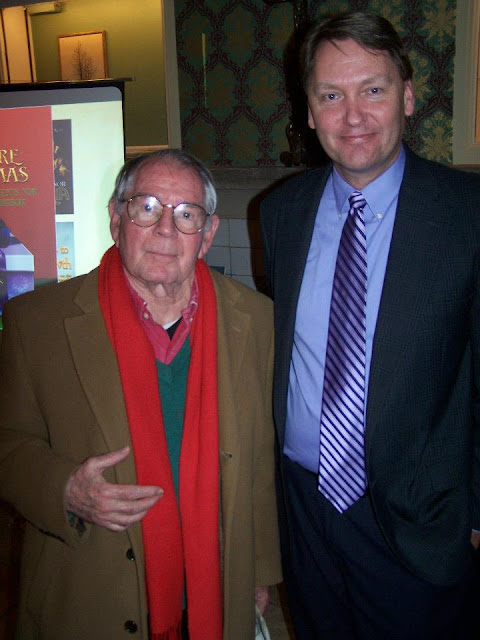As many of you may know already, Walter Hooper passed away today at the age of 89. He served as C. S. Lewis' secretary for a brief period of time in 1963. He later served as one of the executors of C. S. Lewis' literary estate. Walter edited many volumes of Lewis' work and wrote some of the most important secondary works on Lewis. I will leave it to the experts to evaluate Walter's accomplishments in the arena of Lewis studies. I simply wish to take this moment to record my debt to Walter as a friend.
My correspondence with Walter began in 1996 as I was preparing to lead a C. S. Lewis Tour of England for the first time. Walter graciously met with our tour group in Oxford. The photo above was taken at the Eastgate Hotel in the summer of 1997. My wife Becky and I sat at table with Walter and Lewis' step-son, Douglas Gresham.
My next meeting with Walter took place in the summer of 2000. I was in Oxford taking a summer course in religious studies. I contacted Walter to let him know I was in town. He invited me to tea in his flat and we spent hours talking together about everything under the sun. That day Walter very kindly inscribed one of his works to me. It was a copy of Volume I of The Collected Letters of C. S. Lewis. In it, Walter simply wrote, "To Will Vaus from his friend, Walter Hooper" noting the place, Oxford, and the date, August 12, which happened to be my 37th birthday.
From that time on, I would often visit with Walter whenever I was in Oxford. But more often, we would correspond by email. I would write whenever I had a question about Lewis or his works that I thought only Walter could answer. Other than that, I seldom wrote to him because I knew that he must be deluged with correspondence. Despite his busy writing life, Walter would always take the time to patiently respond to my queries.
In 2008, I asked Walter if he would write the Foreword to my second book on Lewis, The Professor of Narnia. Once again, his response was most gracious. He wrote a piece that was beyond what I could ever have hoped for. Walter later recounted to me what Lewis' friend, Owen Barfield, once said to him late in life, namely that his existence consisted mainly at that time of "backwards and forewords". Walter often applied the same description to his own life. He did indeed spend a lot of time looking back to his brief time with C. S. Lewis, and late in life Walter was asked to write many Forewords to books about Lewis.
Walter and I met again in the summer of 2009. Once again, we enjoyed tea in his Oxford flat. At that time, the photos below were taken. On that trip I carried with me a little, plastic dog (Butterscotch) that belonged to my son, and I wrote a blog all about Butterscotch's travels. Walter humbly agreed to pose with Butterscotch and also with me.
On that same trip I was blessed to attend a performance of an opera based upon Lewis' novel, Perelandra. The opera was performed at the Sheldonian, and a number of us enjoyed a splendid meal beforehand in New College. The photos below were taken on that evening...
In 2012 I was in Oxford once again and had the privilege of addressing the Oxford C. S. Lewis Society in Pusey House. My topic for that night was C. S. Lewis and George Macdonald. I was honored and humbled to have Walter Hooper sitting in the front row, listening to my talk.
In the spring of 2015, my friend Russ Head and I traveled to England and Ireland to plan a C. S. Lewis Tour together. Walter invited both of us to tea. Thankfully, on this occasion, I did not have to balance my camera on a bookshelf to get a snapshot of the two of us. Russ took the photo below...










Comments
Many Warm Thoughts,
Rhea
rheatant@gmail.com